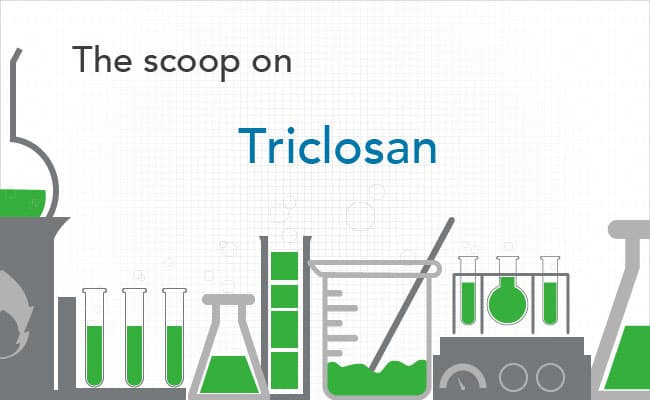
What is triclosan?
Triclosan is a synthetic pesticide that’s often added to detergents and soaps and personal care products like deodorants and toothpastes because it has antibacterial properties [1] [2]. Triclosan does NOT have the power to kill the viruses that cause colds and flus [3]. It is sometimes added to textiles to help them resist the growth of bacteria [1].
What products is triclosan in?
Triclosan is found in a variety of personal care products like antibacterial soaps [3][2], acne products, body washes, disinfectants, deodorants, fragrances, antibacterial dish soaps, and tartar-control toothpastes [3]. In 2016, the FDA banned its use from antibacterial soaps, but manufacturers have one year to comply with the new regulation. The new regulation still permits triclosan’s use in products outside of antibacterial hand soaps.
How to tell if a product has triclosan
Read labels and avoid any listing triclosan or triclocarban.
Risks associated with triclosan
Triclosan can be absorbed through the skin and mouth [1]. The use of too many antibacterial agents like triclosan has been theorized to increase a person’s risk of allergies, asthma, and other illnesses. The European Union banned it in 2010 from products that come into contact with food. Exposure has been linked to the following health issues:
- Hormone disruption
- Increased risk of breast cancer
- Liver damage
- Cancer
- Development of super-germs [2] [3]
How to avoid triclosan
Read labels and use ordinary soap instead of soaps that contain triclosan. Ordinary soap is just as effective at removing bacteria from hands as antibacterial soap. Avoid using anything from socks to training potties that are labeled “antibacterial” [2]. And finally, reduce your use of disinfectant products. Look for toxic chemical free products that are made with natural ingredients without triclosan.
References
[1] CDC (2013). National Biomonitoring Program. Available online: http://www.cdc.gov/biomonitoring/triclosan_factsheet.html December 7, 2016.
[2] Healthy Child Healthy World (2013). Triclosan: Skip the Triclosan and Other Antibacterial Products. Available online: http://www.healthychild.org/easy-steps/skip-the-triclosan-and-other-antibacterial-products/ December 7, 2016.
[3] Women’s Voices for the Earth (2016). Chemical of Concern: Triclosan. Available online: http://www.womensvoices.org/avoid-toxic-chemicals/fact-sheets/triclosan/ December 7, 2016.



